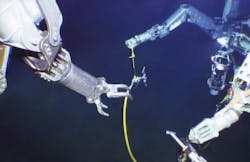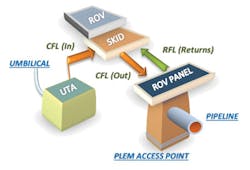ROV-deployed methanol injection systems offer hydrate remediation option
Fernando C. Hernandez
Reaching Ultra
The use of topsides pumps on a host platform to introduce hydrate inhibitors such as methanol into a deepwater pipeline or flowline is a common method to disassociate hydrates in the line, in order to resume production and bring a field (or fields) back online. The blowdown technique, used to decrease the pressure in said lines, can also be employed from a platform as a means of remediating and disassociating hydrate blockages.
The problem with these platform-based methods is that they only allow for singular-sided blockage removal to be performed, while the opposite end of the blockage(s) cannot be accessed due to a lack of secondary topsides facility. This is especially true where there is only one platform that allows for remediation work to take place.
Further, not all production schemes have additional topsides structures that might allow for dual-sided engagement, whereby both sides of a blockage or blockages can be attacked; and this effectively decreases the success rate of remediating a hydrate from a topsides structure.
All of this raises the question: How does an operator introduce methanol to the opposite end of a blockage to conduct dual-sided engagement, in the absence of an additional platform?
The answer to the above question is a three-pronged approach that sources methanol via the topsides; subsea methods that include re-routing methanol from strategic subsea points via an ROV; while also employing a hybrid of ROV intervention, equipment, and techniques.
Attachable bladders
One particular method for sourcing methanol is achieved by deploying methanol-resistant bladders to operational depth via an ROV, in order for it to engage strategically with pre-determined pipeline engagement/access points. The bladder(s) are carefully filled with methanol on the back deck of a DP-2 multi-service vessel before being deployed via an ROV.
Prior to subsea interfacing taking place, the bladders have to be encaged and mounted onto an ROV’s exoskeleton, or within an ROV-attachable skid. In either case, the bladders are plumbed directly to an auxiliary ROV pump which allows for a connection to take place with hot stab receptacle that exists on a pipeline end manifold (PLEM) or other subsea assets. (Mating to said receptacle is accomplished via a flying lead with that has a matching hot stab that connects to the ROV pump.) With the aforementioned configuration in place, an ROV can be launched subsea.
Once an ROV is at the engagement point, the flying lead is then installed. Manipulating the pipeline’s gateway valve(s) follows, and this in turn allows for methanol to be introduced into a flowline/pipeline.
Next, the ROV’s auxiliary pump is energized, beginning the process of drawing methanol from the bladders (which are collapsible), and introducing it into the pipeline. Moreover, because an ROV has a high degree of maneuverability, it is akin to a remote and mobile subsea pumping station that can perform at depths exceeding 8,000 ft. Due to this, an ROV can target multiple points in a production scheme; be positioned closer to a blockage, when compared to topsides methods; and in certain cases, depending on the subsea infrastructure, it allows for dual-sided engagement of the hydrate blockage.
Mud mat installed bladders
It must be noted that ROV-deployable bladders have their limitations, especially when a blockage is located miles from the hydrate access point. In such a case, the blockage can outstrip a bladder’s volume capabilities. The inner diameter of the pipeline must also be accounted for. And in this type of scenario, an ROV will have to make multiple trips to the surface to have its bladders replenished, leading to downtime.
Conversely, mud mat-based bladders greatly decrease the need for replenishment, since they increase the usable volume which can be placed within a pipeline. These bladders can store thousands of gallons of methanol. Furthermore, owing to their size and weight, they must be launched to depth via a vessel’s crane and landed on a mud mat, to ensure they do not sink below the mudline. An ROV assists in landing the bladder.
It is vitally important that once the bladder is landed, that two independent flying leads be deployed to a pipeline access point. One flying lead is used to bridge a path of continuity between the ROV and the bladder, while the other one jumps out from the ROV, establishing a path of continuity with the hydrate engagement point. Here too, an ROV’s auxiliary pump draws methanol from the bladder and injects it into a pipeline. These larger bladders are not immune to having to be tripped to surface. But because of their volume capabilities, such trips are significantly reduced. Additionally, due to their volume capabilities, they are able to more efficiently - when compared to ROV-attachable bladders - conduct the following critical maneuvers:
Bullhead. Methanol is pumped at a predetermined pressure to dislodge the blockage. This method, however, can further compound a hydrate by increasing the pipeline’s pressure, and compacting a hydrate.
Soak. This method does not aim to dislodge the blockage by pumping methanol. Instead, its aim is to make contact with minimal pressure while allowing the methanol to act on the blockage.
Bullhead and soak. Methanol is used to bullhead against a soaked hydrate, but where multiple hydrates exist, bullheading against the ensuing blockage may not be successful. Here, soaking is once more used prior to bullheading again.
UTA engagement
A blockage that is located miles from an engagement point, requires sourcing large amounts of methanol, and in certain cases outstrips a mud mat bladder’s capabilities. This, in turn, can hinder operations significantly. Such a scenario raises the following questions:
What course of action is to be taken when these larger bladders have spent all of their methanol?
Is there an additional means of sourcing methanol for extensive pipeline lengths?
The answer to these questions lies in repurposing umbilical termination assemblies (UTAs) which provide fiber optics, control fluids, electrical power, and chemicals such as methanol to subsea assets. These mediums are delivered from a topsides facility to subsea assets via an umbilical that connects directly to a UTA. The UTA then relies on flying leads with junction plates to bridge a path of communication with adjacent assets on the seafloor, so as to energize and make subsea-to-topsides communications functional.
The key to repurposing a UTA lies in using one of the existing flying leads connected to it. Moreover, one end of the lead continues having the same type of junction plate that allows for it to connect to a UTA, while the other end is configured with a hot stab, for example, to route the methanol to a subsea bladder. It should be noted that it is imperative that the flying lead to be repurposed not affect any other part of the production scheme’s operations. With this complete, a mud mat bladder can be refilled at depth, while a secondary bladder can be used to interface directly with the pipeline via an ROV.
Further, once the secondary bladder is depleted, it can then be replenished while the primary bladder is used to supply chemicals into a pipeline. It must be noted that when the jump-out distances of flying leads and UTAs are combined, it can create extensive jump-out distances. It is this feature that allows an operator to tap into a facility’s methanol reserves and deliver them to a pipeline access point’s that are relatively far from the UTA. It is worth mentioning that topsides facilities have greater real estate to store and house methanol to refill these bladders. In addition, supply boats can readily replenish the depleted methanol on a topsides facility.
Conversely, the DP-2 multi-service vessel from which an ROV is deployed can also employ a hybrid and floating UTA (designed solely for intervention), which in turn permits an ROV to bridge a path of continuity via a flying lead with the hybrid UTA and equally refill the bladders. In other cases, the hybrid UTA is connected directly to an access point.
Importance of dosing
The use of UTAs is key in not only introducing methanol into a pipeline, but in also dosing hydrates which have been disassociated, as well as treating the content which is being removed from a pipeline via depressurization/hydrate remediation equipment. During dosing operations, methanol does not enter the pipeline nor does it make contact with the hydrate blockage itself. Moreover, disassociation has its operational challenges due to the hydrate formation phenomenon, where hydrates shift, migrate, and reform in a very dynamic fashion when removed from the pipeline itself.
Dosing is imperative due to the fact that this technique treats the pipeline’s disassociated hydrates and content which are exiting, while ensuring that the equipment making contact with a hydrate does not become blocked by a hydrate. Operationally speaking, applying a vacuum is instrumental in decreasing a pipeline’s pressure - one of the key elements that creates hydrates - to disassociate a hydrate by way of ROV skids, front porch ROV-mountable equipment, and seabed based equipment that is landed on mud mats.
Historically, prior to the dosing technique becoming part of the remediation tool box, the hydrate engagement point was highly susceptible to hydrate reformation, since it is there that the entire pipeline/flowline’s contents exited. This too applied to the flying lead that connects the hydrate equipment to the access point. Thus when a blockage occurred in these areas, it required disconnecting of all the subsea equipment. Crews would have to bring the equipment to warmer water - to disassociate the hydrate - prior to resuming operations once more. This, of course, led to more downtime, as the equipment would then have to be installed subsea once more. Depending on the severity of the reforming hydrates impacting the subsea equipment, this could lead to the equipment being recovered and re-installed multiple times.
Path forward
The use of the dosing technique in today’s remediation operations has considerably reduced the reformation phenomenon, decreasing downtime. Such success is due to the strategic use of an ROV panel on a pipeline engagement point, which allows for simultaneous dosing and vacuum operations to take place.
Conversely, should a panel not have such simultaneous features, a bespoke ROV panel can be installed on an asset such a manifold’s hub. Such fit-for-purpose panels ensure that when a pipeline’s contents begin to be removed via the returns flying lead (RFL), it is immediately treated with methanol via a chemical flying lead (CFL) that carries methanol to the ROV panel. Moreover, the vacuum being applied by the remediating equipment ensures that the methanol travels out with the RFL.
Delivering methanol to said panel is accomplished via ROV auxiliary pumps mounted on an ROV or skid. One pump draws methanol from the bladders mounted on a skid (methanol out), while the other pulls a vacuum (returns). As an added precautionary measure, the remediation equipment can also have methanol routed within its circuitry. It is important to note that larger seabed-based remediation systems are configured faintly different, but in large part operate in the same fashion as ROV remediation skids. The main difference lies in the fact that the ROV solely provides the seabed system with methanol, and does not carry out remediation operations.
Conclusion
Remediating and treating hydrates will continue to be a critical operational concern in deepwater. This is especially true when a field is rendered inoperable and accessing a hydrate via a platform is not feasible. To address these challenges, new and advanced methods allow for areas of a production scheme that would otherwise be unreachable via conventional means to be targeted and engaged, thus increasing the likelihood of removing a hydrate by introducing methanol into a pipeline, while also being able to apply a vacuum.


